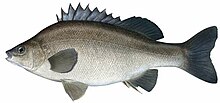Bidyanus bidyanus
| Bidyanus bidyanus | |
|---|---|
 |
|
| Scientific classification | |
| Kingdom: | Animalia |
| Phylum: | Chordata |
| Class: | Actinopterygii |
| Order: | Perciformes |
| Family: | Terapontidae |
| Genus: | Bidyanus |
| Species: | B. bidyanus |
| Binomial name | |
|
Bidyanus bidyanus (Mitchell, 1838) |
|
The silver perch (Bidyanus bidyanus) is a medium-sized freshwater fish of the family Terapontidae endemic to the Murray-Darling river system in south-eastern Australia.
The silver perch's scientific name comes from an aboriginal name for the species — Bidyan — recorded by Major Mitchell on the Barwon River on his 1832 expedition. (Mitchell's original scientific name for the species was Cernua Bidyana.) Silver perch are not a "true" perch of the Perca genus, but are instead a member of Terapontidae or 'grunter' family. They are the largest member of the Terapontidae, capable of growing in excess of 60 cm and close to 8 kg, but today wild river specimens are typically 30–40 cm and 1.0–1.5 kg.
The silver perch is the only major representative of the Terapontidae family in the southern Murray-Darling system, compared to northern tropical systems where terapontid species are common. Another small terapontid, the spangled perch (Leiopotherapon unicolor), does occur sporadically in the northern Murray-Darling Basin.
The silver perch is a large grunter with a small head, small eyes, a small mouth at the end of a pointed 'beak-like' snout. The species is streamlined and laterally compressed, with a spiny dorsal fin of medium height, angular soft dorsal and anal fins and a forked tail. Large specimens become very deep bodied with a large hump behind the head. In terms of colouration, they are dark grey to silvery greyish-brown on the back, silver-grey on the sides, with darker scale margins giving a checkered pattern; the belly is whitish; the dorsal and caudal fins are dark, the pelvic fins white.
Silver perch are omnivorous, feeding on insect larvae, molluscs, annelid worms and algae. The importance of vegetative matter in the diet of silver perch is still debated. Silver perch appear primarily to be a low-order predator of small aquatic invertebrate prey, with occasional intakes of small fish and vegetative matter. In aquaria, silver perch are reported to take blood worms readily.
Silver perch are schooling mid-water fish with a preference for flowing water. Though found in the lowland reaches of the Murray-Darling system, they formerly had a very significant presence in the slope and upland reaches as well. In particular, they had a very strong presence in upland reaches of the Murrumbidgee River and originally were found as far upstream as Cooma. As recently as the early 1980s, long summer migrations into the upland reaches of rivers like the Murrumbidgee were once an annual event. Unfortunately silver perch are functionally extinct in the Murrumbidgee River now, as in most parts of their former range.
...
Wikipedia

